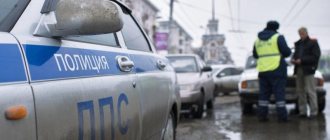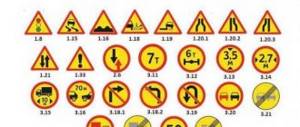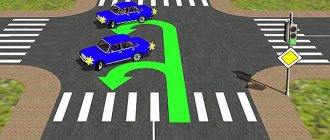| Question | Answer |
| Is it the inspector's responsibility to present his official ID? | A driver or pedestrian stopped by a traffic police officer has the right to demand that the inspector present an official document. The employee must show it by unfolding it, but is not obliged to hand it over to third parties. |
| Why might a vehicle driver need data from an inspector’s official ID? |
|
| What is the procedure for communication between the inspector and the vehicle driver? | The inspector must communicate with the individual in a formal, polite manner. He must remain tactful and be objective. Addressing “You” is acceptable. The requirements and comments voiced by the inspector must be clear, convincing and unambiguous. The employee must show calm and restraint. |
How to legalize changes in the design of a vehicle so that you don’t have to pay fines...
When stopping a vehicle, the traffic police inspector is obliged to present the service identification card in expanded form at the request of the driver - a road user.
Such actions will help protect against scammers who often take advantage of the legal illiteracy of the country's population.
What you should pay attention to will be discussed in this article.
Appearance of the ID
A traffic police certificate is an official document that allows you to identify the identity of the inspector, his position and rank, and confirm his affiliation with the Ministry of Internal Affairs, in particular a certain territorial body (unit).
Issued upon appointment (admission, enrollment, transfer, assignment of title), change in personal information and the name of a structural unit, expiration of the validity period, as well as to replace a stolen, lost or damaged document.
In accordance with the order of the Ministry of Internal Affairs No. 1234, the ID of an employee of the State Traffic Inspectorate can only be used in the performance of their duties and only for official purposes.
It is a “crust” of dark red or burgundy color, on the title page of which there is the inscription “Ministry of Internal Affairs of Russia”; the republic, region, territory within the state to which the traffic police inspector belongs can also be indicated.
What to do if your car has been towed - where to call the driver?
You can verify the authenticity of your service ID by opening it. The spread contains 2 pages. On the first (left side) there is a photograph of a traffic police officer on a white background, the right corner of which is marked with the seal of the structure. Under the photo you can see the inspector’s personal number (one letter and several numbers). Next to the photo is the coat of arms of the Russian Federation, under which “Ministry of Internal Affairs of Russia” is written in red letters. Below is the service region code and document number. The following is the date until which the certificate is valid.
On the second page (right side) there is the inscription “Department of the Ministry of Internal Affairs of Russia for (name of region and locality).” Below is the inscription “Service ID with the letter designation of the territorial unit of service and the document number.” Next, there is a record of the employee’s rank, his full name, and position. Under the personal information there is information about the right to own and use service weapons. The last line of the document is the signature and full name of the chief or his deputy of the territorial body of the Ministry of Internal Affairs and the date of issue of the document.
Protocol on an administrative offense - how can a driver protect his rights?
The authenticity of the official “crust” is verified by the presence of a wet seal, which represents the state emblem in two circles of different sizes and has the inscription Ministry of Internal Affairs of the Russian Federation. The diameter of the seal is 25 mm, which is regulated by state standards.
What should a traffic police officer's official ID look like?
The inspector's document is a dark red or burgundy “scrap” with the inscription “Ministry of Internal Affairs of Russia.” Instead of the name of the country, the republic within it may be indicated. But the motorist should be interested in what is inside. The law speaks about this, in particular, the 5th paragraph of paragraph 20 of the Order of the Ministry of Internal Affairs No. 185 of March 2, 2009, supplementing the “Administrative Regulations..”:
When stopping a vehicle or pedestrian, the employee, at the request of a road user, is obliged to present an expanded service ID without letting it go.
The documents of the Ministry of Internal Affairs also apply to the State Traffic Safety Inspectorate, since the inspectorate is its structural unit.
A genuine ID has the following characteristics:
- On the left side of the document there should be a color photograph of the person presenting it in uniform, on a white background. Its lower right corner is marked with a round seal of the Ministry of Internal Affairs. The employee's personal number is located under the photo. It consists of the first letter and several numbers.
To the right of the photo at the same level there should be an image of the coat of arms of the Russian Federation. Below it is the inscription “Ministry of Internal Affairs of Russia” printed in red paint. Even lower is the three-letter code of the region in which the inspector serves and the license number. And at the very bottom, on the same level as the employee’s personal number, there is information about the validity period of the document.
- On the right side at the top there is an inscription notifying about the department of the Ministry of Internal Affairs in which the inspector serves, with the full name of the region (region, republic or region). Below is the printed inscription “service ID” with the letter code of the territory, as well as the document number (the numbers are the same as on the left half of the “stamps”). Below it are the employee’s title, full name and position (for example, “traffic police inspector” or “state traffic police inspector”).
Below in small letters is printed information that the holder of the document has the right to a service weapon. Below it, on the same level, is the designation “Chief (Deputy)” and his signature. It should be deciphered, but some may not have the surname of a higher-ranking employee legibly written. The bottom line on the right side of the certificate is the date of issue. It is located closer to the left edge.
We recommend reading about suspension from driving. You will learn about the grounds for removal from driving a vehicle, the procedure for carrying out this procedure, and drawing up a protocol. And here is more information about how to properly communicate with a traffic police inspector in different situations.
Does the traffic police officer have to present a certificate?
All rights and obligations of employees of the Ministry of Internal Affairs are enshrined in the Federal Law “On Police”. The actions of traffic police officers are also regulated by Order No. 664, according to which an inspector who is on duty during a stop of a vehicle or a pedestrian is obliged to present his official identification card in an open form, without letting go of his hands.
At the same time, communication with road users must be polite and tactful, all judgments must be objective.
The police officer must address the driver as “you”, and state all requirements in an accessible form, excluding double interpretation.
Bribe to a traffic police officer.
First of all, you need to decide what is considered a bribe. Its definition in Russian law is given by the Criminal Code in Art. 290:
- “Receipt by an official, a foreign official or an official of a public international organization personally or through an intermediary of a bribe in the form of money, securities, other property or in the form of illegal provision of services of a property nature, provision of other property rights (including when the bribe is ordered by of an official is transferred to another individual or legal entity) for committing actions (inaction) in favor of the bribe-giver or persons represented by him, if these actions (inaction) are within the official powers of the official or if, by virtue of his official position, he can contribute to these actions (inaction), as well as for general patronage or connivance in the service.”
This means the following:
- Money or other material assets are transferred to the official. The traffic police inspector, being on duty, is one of them.
- A bribe is given for actions that are within the authority of such a person. If, for example, your car broke down, a kind inspector allowed you to call a tow truck from his personal phone, and you gave him money for it as a token of gratitude - this cannot be considered a bribe: the duties of the traffic police do not include the provision of communication services, so the money will be considered as a gift. True, if at the same time you become generous and give the inspector more than 3,000 rubles, he will be obliged to hand over this money to the cashier: officials are prohibited from accepting gifts in excess of this amount from citizens.
What to do if he refuses
If the traffic police inspector refuses to present his official identification, the driver should have suspicions about the legality of the actions of the person who stopped the vehicle. In this case, you must notify the traffic police officer about the call to check your data. You can use several options and call:
- to the Ministry of Internal Affairs hotline using a single number - 102;
- to the emergency service – 112;
- helpline, which is located on the patrol car.
I was deceived at a car service center - where can I complain?
After the operator’s response, it is necessary to indicate that outside the traffic police post, a citizen who introduced himself (indicate rank, position and full name), wearing a traffic police uniform, stopped the car and refused to present his ID as a State Traffic Inspectorate inspector. Such actions will help determine whether a citizen is truly a police officer.
Does the inspector have to present his document?
Paragraph 3, clause 2.4 of the Traffic Regulations states that a person who has the authority to stop cars, after the driver’s request, is obliged to present an official ID. And according to paragraph 45 of Order of the Ministry of Internal Affairs of the Russian Federation No. 664 dated August 23, 2017 “On approval of the Administrative Regulations,” this document is presented in expanded form, but it is prohibited to let it out of hand. In this case, the first thing a traffic police officer must do in accordance with the Rules after stopping a car is to introduce himself (state his last name, rank, position) and indicate the reason for the stop. After this, the driver can ask to provide a certificate, but without this requirement the inspector is not obliged to obtain the document.
However, all road users are strongly recommended to require this document in order to first of all make sure that the inspector is real and not a fraudster. And also to verify the data specified in the protocol and in the certificate, since the traffic cop may deliberately provide false information. So, if a car is stopped by a traffic police officer, the driver must:
- Wait until your name, title and position are announced.
- Ask to see the ID so that all the information on it is visible.
- Demand not to hide the document this very second, so that you can transfer all the data to your notebook.
- Do not try to take it into your own hands, as this is prohibited by law.
- Report a fake or expired document to the duty station using the number indicated on the inspector’s car.
Another reason why it is recommended to rewrite all the information from the service ID is that this information will help to find in the future the traffic police inspector who took all the documents and deliberately did not return them or issued them, but forgot one and it remained with him. Such actions on the part of a representative of the state traffic police will be illegal, and the injured driver can write a claim (complaint) to management or to higher authorities.
Rules for studying the ID
The traffic police officer's service ID must be examined:
- in order to verify the legality of the actions of a person representing the structure of the Ministry of Internal Affairs;
- to obtain information about the unit to which a complaint can be sent in case of violation of the driver’s rights and duties by the inspector;
- to verify the information specified in the document and the protocol;
- to apply if the employee has not returned the license that he checked.
In order to make sure that the traffic police inspector, who is performing official actions legally, is in front of the driver, the driver should be asked to show his ID. To study the information, you must ask to open the document.
Important! The State Traffic Inspectorate employee is obliged to keep the “crust” open until the motorist has studied all the information. If necessary (in case of illegal actions of the policeman), the driver has the right to rewrite the document data.
Responsibility of a traffic police officer.
A traffic police officer who takes money from a driver for not drawing up a report, or for drawing up one for a less serious violation, no longer commits an administrative violation, but a criminal offense. And in this case, he will face punishment under Art. 290 of the Criminal Code of the Russian Federation:
- For a small amount (up to 25 thousand rubles) - from a fine of up to 1 million rubles to imprisonment of up to 3 years.
- For a significant amount (over 25 thousand) - from a fine of up to one and a half million rubles to imprisonment for up to 6 years.
- For a large amount (from 150 thousand) - from a fine of up to 4 million to imprisonment for a term of 7 to 12 years. The same punishment awaits the inspector who openly extorted a bribe.
- For a particularly large amount (over 1 million) - from a fine of 3 million to imprisonment from 8 to 15 years.
- If the bribe was taken for obviously illegal actions (for example, during an accident, the inspector indicated a completely different person as the culprit in the documents, although he knew the truth) - a fine from half a million to 2 million, or imprisonment from 3 to 8 years.
It must be remembered that imprisonment and a fine do not exclude each other: the jailed inspector may well pay an additional fine. In addition, he may be additionally prohibited from holding certain positions for different periods, depending on the severity of the crime.
If the document is expired
The Federal Law of the Russian Federation “On the Police” states that a service ID allows you to identify the identity of a traffic police inspector, his position, rank, full name and affiliation with a certain structure of the Ministry of Internal Affairs. Also confirms the legal right to own firearms. The legal act does not indicate the validity period of the document. Delay may be due to technical reasons that are beyond the employee’s control, for example, lack of forms.
How to transport oversized cargo - what do traffic regulations say in 2021?
Therefore, if a driver is stopped by a traffic police inspector with an expired license, it is necessary to comply with all his requirements. In order to verify the legality of the actions, you should call the helpline of the Ministry of Internal Affairs, the uniform police number -102 or the rescue service - 112.
What should a driver do if his request is refused?
If, after the driver reminds you to present your license, the traffic police officer refuses to do this or takes it out and immediately puts it back in his pocket, without giving you the opportunity to study the information contained in it and rewrite it, then it is recommended to contact the following numbers, having previously notified the stopping inspector:
- The uniform number of the Ministry of Internal Affairs is 102;
- Emergency service - 112;
- Helpline (its number is usually printed on the inspector’s car);
- “Hotline” 8-800-250-02-35 or 8 (495) 667–74–47;
- Main Department of Internal Security - 8 (495) 667-07-30.
By phone, you must inform where exactly outside the stationary post a person in a traffic police uniform stopped the car to check documents and that he refused to present his ID. This call will help determine exactly who stopped the car owner - a real traffic police officer or a fraudster. If the person stopped turns out to be a “fake” traffic cop, then you must immediately close and lock all doors and windows and drive to a safe distance.
Does a freelancer or vigilante have the right to stop a vehicle and how should the driver behave?
A freelance police officer is a citizen who is not an official of the Ministry of Internal Affairs and has expressed a desire to provide assistance in performing duties on a free and voluntary basis.
In accordance with the law, such persons have the right to participate in ensuring road safety and have the same rights and responsibilities as a traffic police inspector. However, a freelancer must perform all actions under the guidance of the traffic police officer to whom he is assigned.
To maintain order and ensure safety on the road, a certificate of the established form is issued. Otherwise, all actions of a citizen are unlawful.
Traffic police vigilantes are citizens who have expressed a voluntary desire to assist traffic police officers in ensuring public order and safety on the road. To perform the assigned duties, a certificate and badge are issued, as well as a special cape with the appropriate inscription.
GPS beacon for a car - will it help you find a stolen car?
The police officer has the right to stop the vehicle and ask for documents for inspection only in close cooperation with the traffic police. The driver is not required to give up his license. In this case, the voluntary person notifies the traffic police inspector, who examines the driver’s license.
Why do you need to require identity documents from traffic police, traffic police, traffic police?
In fact, the organization that monitors compliance with traffic rules and ensures safety on the road is called the State Traffic Safety Inspectorate, and the traffic police is its structural division. It is these abbreviations that can be found on the documents of inspectors, and not “traffic police”. The need to ask service employees for identification exists for:
- Reconciliation of information in the protocol and document. The inspector may make a mistake or deliberately provide incorrect data. And this is already a reason to challenge the punishment imposed by him.
- To determine whether a real inspector is making a claim or a person with fake “credentials” who is not related to the organization. This will help not only save money, but also the driver’s documents, car, and sometimes his life.
- Combating illegal actions of a real traffic police officer. Information from the ID will help to find him if he took and does not give back documents belonging to the driver. Knowing them, it is easy to contact the department where an unscrupulous employee works. The same information in the copy of the protocol that the driver receives in his hands may be written illegibly.
More on AutoLex.Net:
Rules for drivers who do not want to get a fine for a taxi










